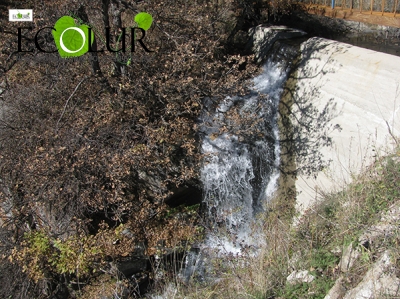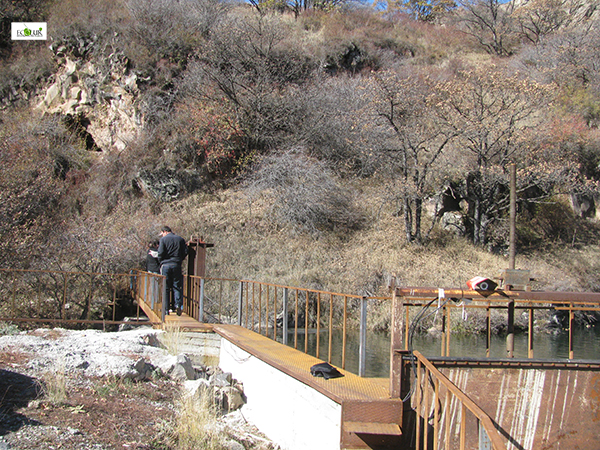

EcoLur
In the framework of the project entitled “Support to SHPP-relating Reforms Through the Dialogue of Public and RA Nature Protection Ministry for Sustainable Use of River Ecosystems” the expert group visited “Nane” SHPP. “Nane” SHPP is located in Vayots Dzor Region, in the administrative area of Hermon community. The SHPP is constructed on the Aysas Tributary to Karakaya Tributary to Yeghegis River (length – 12 km). It’s operated by “ARATES ENERGY” LLC.
As a result of the monitoring, the expert group found out:
· The SHPP has been operating since 2014.
· According to the project, the static pressure of the SHPP is 354 m, according to the certificate issued by the Public Services Regulatory Committee on 1 October 2015 and the project, the estimated pressure of the SHPP is 314.65 m. According to PSRC certificate and the project, the estimated yield used by the SHPP is 1.25 m3/s. According to the project, the projected capacity is 3380 kW and the PSRC certificate says it’s 3048 kW. According to the PSRC, as of October 2015 the factual useful delivery of the electricity is 8.497 million kWh, the estimated production of the SHPP is 8.497 million kWh, duration of license - 11.06.2014-11.06.2029, water usage permit 19.01.2015 - 19.01.2016.
· The length of the concrete dam of “Nane” SHPP is 11 meters, its height is 7 meters.
· There is no fish passway, though the project plans it. The fish passway hasn’t been constructed with the substantiation that the dam gets supplied directly from the natural waterfall water.
· There is a garbage collector installed with 2-3-centimeter-long bars.
· You can meet the following fish species in this section of the Aysas River: Kura barbell and brown trout.
· The length of the steel pipeline is 2726 m and its diameter is 0.8 m, according to the project.
· Percentage correlation of aggregate length of SHPP derivation pipelines (5996 meters) of “Nane” SHPP (the length of the derivation pipeline is 2726 meters, according to the project) and “Hermon” SHPP (according to the PSRC, it’s length is 3270m), with the length of the Aysas River (12 km) makes up 49.96 %.
· According to the water usage permit, “Nane” SHPP can ensure 0.04 cum/s environmental flow in the river.
· According to “Computation Center” CJSC data, in 2014 “Khachaghbyur” SHPP operated for 8 months in 2014 and produced 3235752 kW electricity.
· There are two aggegates of Chinese production installed in the station, and at the moment of observation only one was operating with 330 kW capacity.
· The transformer substation is fenced, the installed transformer is not equipped with oil-collecting system.
· Automatic management and recording of water intake and environmental flow is not ensured.
· There is no entire automatic management system in the station.
· There is no water-meter sealed by a relevant environmental body in the water intake. There is a water-measuring bar.
· The SHPP planted about 1000 trees along the village road. The station area is improved and greened.
· The requirements of free water use are complied with.
· There are no violations of landscape and signs of landslide.
· The discharge of construction garbage and household wastes is carried out.
· The State Environmental Inspection of Nature Protection Ministry hasn’t carried out any inspections in the SHPP.
Conclusion
It’s obious from hydrological data that the SHPP shouldn’t operate in low-water season.
Proposals
· To ensure automatic management of environmental flow in the head section, installation of water-measuring devices and online control.
· To reconstruct the fish passway.
· To review the amount of environmental flow to increase it, as the environmental flow of 0.04 cum/s is too low and can’t ensure the natural state of the river ecosystem and biodiversity.
·To equip the transformer with an oil-collecting system.
 |
 |
 |
 |
 |
 |
 |
 |
 |
 |
 |
 |
 |
 |
The material was developed in the frames of “Supporting reforms in the sector of small hydro power plants through enabling a dialogue between civil society and the Ministry of Nature Protection for sustainable use of river ecosystems” supported by UNDP/GEF Small Grants Programme".
April 06, 2016 at 15:56
